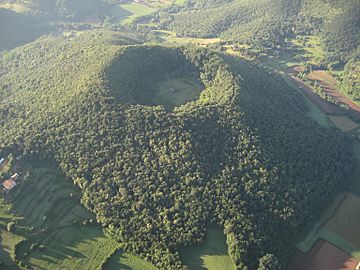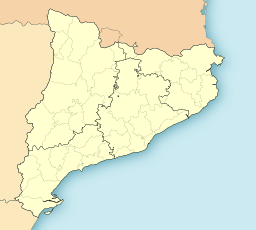Santa Margarida Volcano facts for kids
Quick facts for kids Santa Margarida Volcano |
|
|---|---|

Aerial view of the Santa Margarida Volcano
|
|
| Highest point | |
| Elevation | 682 m (2,238 ft) |
| Geography | |
| Location | Santa Pau, Garrotxa, Catalonia, Spain |
| Geology | |
| Volcanic arc/belt | Garrotxa Volcanic Zone |
The Santa Margarida Volcano (called Volcà de Santa Margarida in Catalan) is an extinct volcano located in the Garrotxa area of Catalonia, Spain. An extinct volcano is one that scientists believe will never erupt again.
This volcano is about 682 meters (2,238 feet) tall. Its base measures 2 kilometers (1.2 miles) around. It is a key part of the Zona Volcànica de la Garrotxa Natural Park, a special area known for its many old volcanoes.
Inside the volcano's main crater, there is a small church called the hermitage of Santa Margarida. The volcano was named after this building. The original church was destroyed by a big earthquake in 1428. It was later rebuilt in 1865.
How the Volcano Formed
Scientists have studied the Santa Margarida Volcano to understand its past. A study from 2011 showed that it formed about 11,500 years ago.
A Twin Eruption
This study suggests that Santa Margarida and a nearby volcano called Croscat were created during the same big eruption. This eruption was a mix of two types of activity:
- Phreatomagmatic activity: This happens when hot magma (melted rock from deep inside the Earth) mixes with water. This creates powerful, explosive eruptions.
- Magmatic activity: This is when magma erupts directly from the volcano.
So, the volcanoes grew as these different types of eruptions happened one after another.
Gallery
See also
- List of volcanoes in Spain
- You can learn more about the Santa Margarida Volcano in Spanish on Kiddle for kids.



